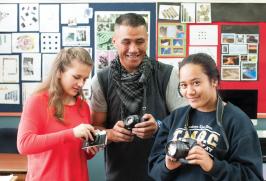Digital technologies implementation process
Four levels of implementation
Below are the action steps for the level your school is at in the implementation of digital technologies in the revised technology learning area.
To see an overview of all the levels go to digital technologies implementation support tool.
Leading and innovating

Download PDF:
Leading and innovating DT implementation support 2020 (PDF, 1 MB)
Formally prioritising future-focused learning
As the school leader / leadership team / curriculum and change leaders, you:
- have structured meaningful school and community collaboration in connection with developing your local curriculum and are prioritising technology learning.
- Your local curriculum is future-focused for learners thriving in a transforming digital world.
- support practices where teachers are encouraged to innovate and learn alongside their students are teaching technology learning so that it is cross-curricular. Teachers create learning experiences that connect ideas across the breadth of the curriculum.
- This includes teaching technology across learning areas and simultaneously developing key competencies: managing self, relating to others, participating and contributing, thinking, and using language, symbols and texts (see alert #7 below).
- continue to filter out information about digital technologies learning to all school staff and students, and community where possible.
- have a digital device resource plan, and it’s based around the new digital technologies learning in The New Zealand Curriculum.
- records showing that all those teaching the technology learning area and middle leaders are participating in ongoing professional learning and the difference that is making with regard to their planning, teaching, and student learning.
Alert #7
Know the goal for learning across years 1–10 and 11–13 for each learning area, and have a plan for how all of your students will be able to access these opportunities.

Feeling confident with an Ako style of teaching and learning
As teachers, you:
- have talked to your students, and you and they feel comfortable using digital technologies vocabulary for example, algorithm, inputs, outputs, sequence, iteration, binary, and debug
- use student expertise in the classroom and where possible allow students to design curriculum learning activities.
Formally prioritising future-focused learning for all in strategic documentation and resourcing
As the board of trustees, you have:
- prioritised digital technologies learning in your strategic goals and planning
- a plan to resource full implementation across the school
- a plan to evaluate progress.
Storytelling – how one school introduced digital technologies
Ohaewai Primary School and the Battle of Ōhaeawai
Ohaeawai Primary in Northland is a small, 160-student rural school. One of their classes has been set the challenge of discovering more about the famous Battle of Ōhaeawai – to find out more about it, and present their findings back to the school at the end of the term.
The learning objective is to see how the same event can be seen differently by different people. At the same time, the learners need to start thinking about how they could best present their story.
How digital technologies fit:
- step-by-step thinking process
- planning for the needs of the end user when telling their story
- considering the tools they have available to help them bring the story to life.
Field trips
The learners first visited the Museum of Waitangi to learn about the early navigators like Kupe, the early interactions between Māori and Europeans and events surrounding the Treaty signing – including the Battle of Ōhaeawai.
How digital technologies fit:
- refining initial ideas with increasing gathering of information
- storing and retrieving their work from cloud-based programmes.
Next, they visited the Carving Studio in the Waitangi Treaty Grounds, where they heard the stories of the battle that have been told in the carvings. They also learnt more about the Treaty of Waitangi signing.
How digital technologies fit:
- refining initial ideas to bring in new perspectives
- storing and retrieving their work from cloud-based programmes
- thinking how the two points of view fit with the overall plan.
Technological practice
Back in the class, the students gather their thoughts and ideas together in a working group. They start a storyboard that helps them with both their narrative and what tools they can use to bring their stories to life for their audiences.
How digital technologies fit:
- developing a step-by-step process for telling the story sequentially
- exploring digital tools available to help them tell the story – the tools they selected are all freely available online.
For ideas on digital technologies available see:
Once their plan of attack is agreed, the learners begin the fun part – bringing the story to life. The great thing is the range of tools available means there are choices for where learners’ interest or passions lie.
How digital technologies fit:
- developing a piece to camera where learners take the role of a news crew and presenter
- creating a traditional pā using Tinkercad design software
- animating a new output, using models the students have made.
Outcome development and evaluation
The big day arrives. After all that work, the learners are ready to present their story to a large audience. This includes their schoolmates, teachers, family and whānau.
How digital technologies fit
They have developed a presentation using Google slides that features their illustrations, 3D drawings, and video footage.
You might also like ...
Other stories of digital technologies curriculum content being introduced into teaching and learning see teaching snapshots.
Ideas on local curriculum and digital technologies watch the webinar recording – local curriculum projects and digital technologies.
Further support
For more information see: digital technologies questions and answers.
Quick links to professional support package:
Digital technologies and hangarau matihiko learning
Kia Takatū ā-Matihiko | National Digital Readiness Programme
